
Poison dart frog is the common name of a group of frogs in the family Dendrobatidae which are native to tropical Central and South America. These species are diurnal and often have brightly colored bodies. This bright coloration is correlated with the toxicity of the species, making them aposematic. Some species of the family Dendrobatidae exhibit extremely bright coloration along with high toxicity — a feature derived from their diet of ants, mites and termites— while species which eat a much larger variety of prey have cryptic coloration with minimal to no amount of observed toxicity. Many species of this family are threatened due to human infrastructure encroaching on their habitats.

Chytridiomycosis is an infectious disease in amphibians, caused by the chytrid fungi Batrachochytrium dendrobatidis and Batrachochytrium salamandrivorans. Chytridiomycosis has been linked to dramatic population declines or extinctions of amphibian species in western North America, Central America, South America, eastern Australia, east Africa (Tanzania), and Dominica and Montserrat in the Caribbean. Much of the New World is also at risk of the disease arriving within the coming years. The fungus is capable of causing sporadic deaths in some amphibian populations and 100% mortality in others. No effective measure is known for control of the disease in wild populations. Various clinical signs are seen by individuals affected by the disease. A number of options are possible for controlling this disease-causing fungus, though none has proved to be feasible on a large scale. The disease has been proposed as a contributing factor to a global decline in amphibian populations that apparently has affected about 30% of the amphibian species of the world. Some research found evidence insufficient for linking chytrid fungi and chytridiomycosis to global amphibian declines, but more recent research establishes a connection and attributes the spread of the disease to its transmission through international trade routes into native ecosystems.
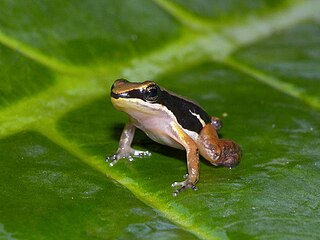
Colostethus is a genus of poison dart frogs native to Central and South America, from Panama south to Colombia, Ecuador, and northern Peru. Their common name is rocket frogs, but this name may refer to frogs in other genera and families, following the taxonomic revision of the genus in 2006.

Indirana brachytarsus is a species of frog found in the Western Ghats of India.

The Panamanian golden frog, also known as Cerro Campana stubfoot toad and other names, is a species of toad endemic to Panama. Panamanian golden frogs inhabit the streams along the mountainous slopes of the Cordilleran cloud forests of west-central Panama. While the IUCN lists it as Critically Endangered, it may in fact have been extinct in the wild since 2007. Individuals have been collected for breeding in captivity in a bid to preserve the species. The alternative common name, Zetek's golden frog, and the epithet zeteki both commemorate the entomologist James Zetek.
Hyloxalus abditaurantius is a species of frog in the family Dendrobatidae. It is endemic to Colombia.
Silverstoneia erasmios is a species of frog in the family Dendrobatidae. It is endemic to Colombia where it is known from the Cordillera Occidental and Cordillera Central in the Antioquia Department.

Leucostethus fraterdanieli is a species of frog in the family Dendrobatidae. It is endemic to the Andes in Colombia. Colostethus yaguara might be its junior synonym.
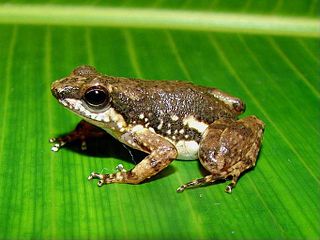
Colostethus inguinalis is a species of frog in the family Dendrobatidae. It is endemic to northwestern and northcentral Colombia. Its vernacular name is common rocket frog, although this name can also refer to Colostethus panamansis that until 2004 was considered a junior synonym of Colostethus inguinalis. Much of the older literature on Colostethus inguinalis is actually about Colostethus panamansis.

Colostethus pratti is a species of frog in the family Dendrobatidae. It is found in the northwestern Colombia and Panama, possibly also in southeastern Costa Rica. It is sometimes known as the Pratt's rocket frog. Colostethus pratti is named after Antwerp Edgar Pratt, an explorer who collected the type series.
Leucostethus ramirezi is a species of frog in the family Dendrobatidae that is endemic to Colombia. It is only known from the region of its type locality, Urrao in the Antioquia Department.
Hyloxalus shuar is a species of frog in the family Dendrobatidae. It is endemic to Ecuador and Peru and is currently known from only two locations, though formerly widespread. The common English-language names Santiago rocket frog and Shuar rocket frog have been proposed for it.

Allobates talamancae is a species of frog in the family Aromobatidae. It is found in northwestern Ecuador, western Colombia, Panama, Costa Rica, and southern Nicaragua.
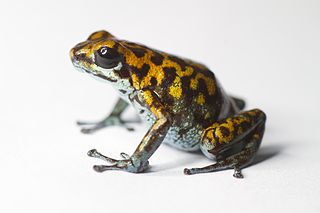
Vicente's poison frog is a species of frog in the family Dendrobatidae that is endemic to the Veraguas and Coclé Provinces of central Panama.
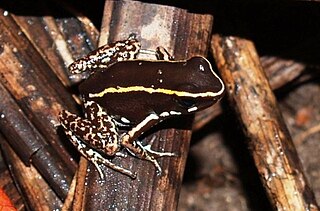
The lovely poison frog or lovely poison-arrow frog is a species of frog in the family Dendrobatidae. It is found on the Caribbean versant of Central America from southeastern Nicaragua through Costa Rica to northwestern Panama, with one record just west of the Panama Canal. Populations from the Pacific versant, formerly included in this species, are now identified as Phyllobates vittatus.

Agalychnis lemur, the lemur leaf frog or lemur frog, is a species of frog in the subfamily Phyllomedusinae. It is found in Costa Rica, Panama, and adjacent northwestern Colombia. It is classed as Critically Endangered and threatened by the fungal disease chytridiomycosis.
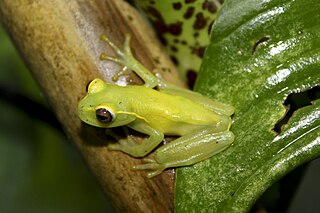
The La Loma tree frog is a species of frog in the family Hylidae found in Costa Rica, Panama, and expected but not confirmed in Colombia. Its natural habitats are tropical moist lowland and montane forests, with breeding taking place in streams. It is threatened by habitat loss and chytridiomycosis.

The green-eyed treefrog is a species of Australasian treefrog in the subfamily Pelodryadinae that occurs in the Wet Tropics of Australia.
Hyloxalus pulcherrimus is a moderately large species of poison dart frog endemic to Peru. It is only known to be found in two streams near Cutervo.
Oophaga andresi, also known as the cocorro, is a species of poison dart frog. It was described in 2018. It is endemic to Colombia's Chocó region.
















